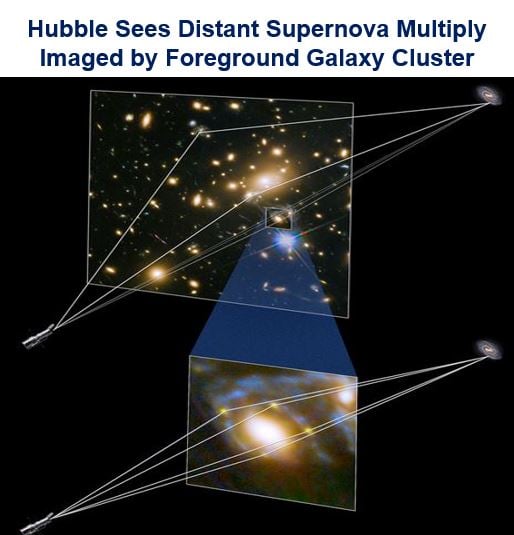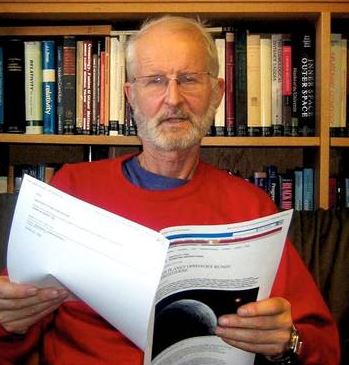Scientists captured four images of an exploding star (supernova) because it was behind a massive cluster of galaxies that bent light and spacetime, creating a gravitational lens, like a giant cosmic magnifying glass.
According to NASA “A supernova is the explosion of a star. It is the largest explosion that takes place in space.”
Over the past decades, astrophysicists have come to realize that the sky is filled with cosmic magnifying glasses that allow astronomers to study very distant and faint bodies barely visible with even the most powerful telescopes.

This Hubble Space Telescope image shows the light from an exploding supernova split into four yellow images (arrows in the box) to form an Einstein Cross. (Image: UC Berkeley)
University of California, Berkeley postdoctoral scholar Patrick Kelly has now found that one of these lenses – a massive galaxy within a galaxy cluster, both of which are gravitationally bending and magnifying light – has projected four distinct images of a single distant supernova.
Gravitational lensing
Gravitational lensing occurs when the light from a very distant object is distorted around a massive object such as a massive galaxy between the bright object and the viewer. Gravitational lensing was one of the predictions in Einstein’s Theory of General Relativity.
Galaxy clusters are the Universe’s biggest structure. Their gravitational force is so powerful that they warp the spacetime around them.
The so-called “Einstein cross” will provide scientists a unique opportunity to study a distant supernova and the distribution of dark matter in the lensing galaxy and cluster.
Dr. Kelly, who discovered the supernova while looking through HST (Hubble Space Telescope) infrared images taken on November 10th, 2014, said:
“Basically, we get to see the supernova four times and measure the time delays between its arrival in the different images, hopefully learning something about the supernova and the kind of star it exploded from, as well as about the gravitational lenses. That will be neat.”
Dr. Kelly is a member of the GLASS (Grism Lens-Amplified Survey from Space) team led by UCLA’s Tommaso Treu, which has worked in collaboration with the FrontierSN team organized by Steve Rodney at Johns Hopkins University to seek out distant supernovae.

Illustration describing how the powerful gravity of a massive galaxy cluster bends and focuses the light from a supernova behind it – gravitational lensing – resulting in multiple images of the exploding star, an Einstein Cross. (Image: UC Berkeley)
A 50-year search
Professor Alex Filippenko, a member of Kelly’s team, said:
“It’s a wonderful discovery. We’ve been searching for a strongly lensed supernova for 50 years, and now we’ve found one. Besides being really cool, it should provide a lot of astrophysically important information.”
One of the advantages offered by gravitational lensing is that astronomers can watch a supernova replay in the next ten years.
This is because light gets distorted in different directions through a gravitational lens, and arrives at earth at different times.
According to computer modelling, this lensing cluster shows that astronomers failed to observe this supernova 50 and 10 years ago, but will be able to see it again within the next ten years.
Prof. Filippenko said:
“The longer the path length, or the stronger the gravitational field through which the light moves, the greater the time delay.”
Dr. Kelly and colleagues have written about the supernova’s appearance in a special March 6th edition of Science (citation below), marking the centenary of Albert Einstein’s General Theory of Relativity.

The distant supernova has been called SN Refsdal, in honour of Sjur Refsdal (1935-2009), a Norwegian astrophysicist who is best known for his pioneer work on gravitational lensing.
The supernova is about 9.3 billion light years from Earth (redshift = 1.5), close to the edge of the observable Universe. The massive galaxy that caused the gravitational lensing is about 5 billion light years from Earth (redshift = 0.5).
Einstein Cross and Einstein Lens
According to Einstein’s General Theory of Relativity, dense concentrations of mass in the Universe will have a lens-effect on light, bending it and magnifying objects behind the mass when viewed from Earth.
Since gravitational lensing was first discovered in 1979 (the SBS 0957+561 Twin Quasar), it has provided a new window into the early Universe shortly after its birth 13.8 billion years ago.
Dr. Kelly said:
“These gravitational lenses are like a natural magnifying glass. It’s like having a much bigger telescope. We can get magnifications of up to 100 times by looking through these galaxy clusters.”
When the path of light is far from the huge mass that bends spacetime, or if the mass is not especially large, “weak lensing” will occur, slightly distorting the background object.
However, when the background object is nearly exactly behind the mass, strong lensing can smear the extended objects such as galaxies into an “Einstein Ring” surrounding the lensing galaxy or galaxy cluster.
Strong lensing of smaller, point-like objects, on the other hand, commonly produces an “Einstein Cross”, i.e. multiple images arrayed around the lens.
Prof. Filippenko said:
“We have seen many distant quasars appear as Einstein crosses, but this is the first time a supernova has been observed in this way.”
“This short-lived object was discovered only because Pat Kelly very carefully examined the HST data and noticed a peculiar pattern. Luck comes to those who are prepared to receive it.”
The galaxy that is distorting and splitting light from the supernova into an Einstein cross is part of a massive cluster called MACS J1149.6+2223, which scientists have known about for over ten years.
Astronomers reported in 2009 that this cluster created the largest known image of a spiral galaxy ever observed through a gravitational lens. This newly observed exploding star is located in one of that galaxy’s spiral arms, which also appears in multiple images around the foreground lensing cluster.
The exploding star, however, is split into four separate images by a red elliptical galaxy within the cluster.
Dr. Kelly said:
“We get strong lensing by a red galaxy, but that galaxy is part of a cluster of galaxies, which is magnifying it more. So we have a double lensing system.”
After discovering the lensed supernova, Dr. Kelly and colleagues examined earlier HST (Hubble Space Telescope) images and saw it very faintly as early as November 3rd (7 days before).
HST has so far taken several dozen images of the supernova using the Wide Field Camera 3 Infrared camera as part of the Grism study. HST astronomers plan to capture even more images and spectra as the HST concentrates for the next six months in that part of the Universe.
Dr. Kelly said:
“By luck, we have been able to follow it very closely in all four images, getting data every two to three days.”
Citation: “Multiple images of a highly magnified supernova formed by an early-type cluster galaxy lens,” Patrick L. Kelly, Louis-Gregory Strolger, Steven A. Rodney, Tommaso Treu, Ryan J. Foley, Gabriel Brammer, Marusa Bradac, Kasper B. Schmidt, Adi Zitrin, Alessandro Sonnenfeld, Or Graur, Alexei V. Filippenko, Saurabh W. Jha, Adam G. Riess, Anja von der Linden, Benjamin J. Weiner, Daniel Scolnic, Matthew A. Malkan, Michele Trenti, Jens Hjorth, Raphael Gavazzi, Adriano Fontana, Julian C. Merten, Curtis McCully, Tucker Jones, Marc Postman, Alan Dressler, Brandon Patel, S. Bradley Cenko, Melissa L. Graham, and Bradley E. Tucker. Science. First published 6 March, 2015. DOI: 10.1126/science.aaa3350.
HubbleESA Video – Animation of four images of supernova
